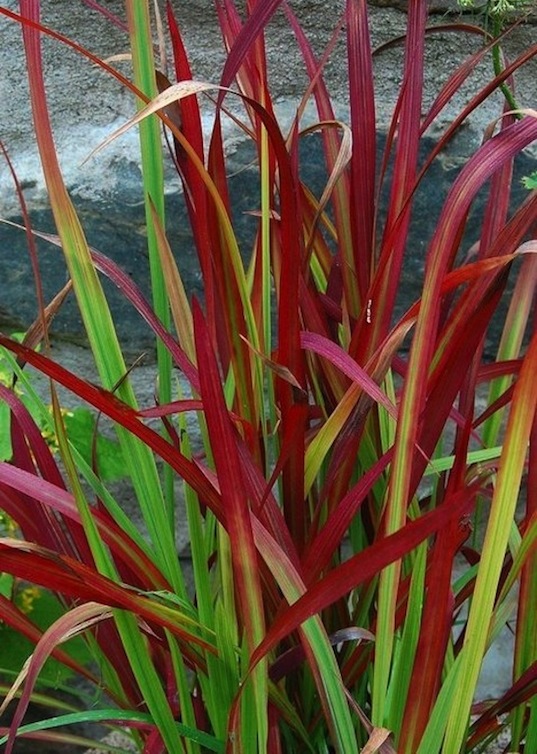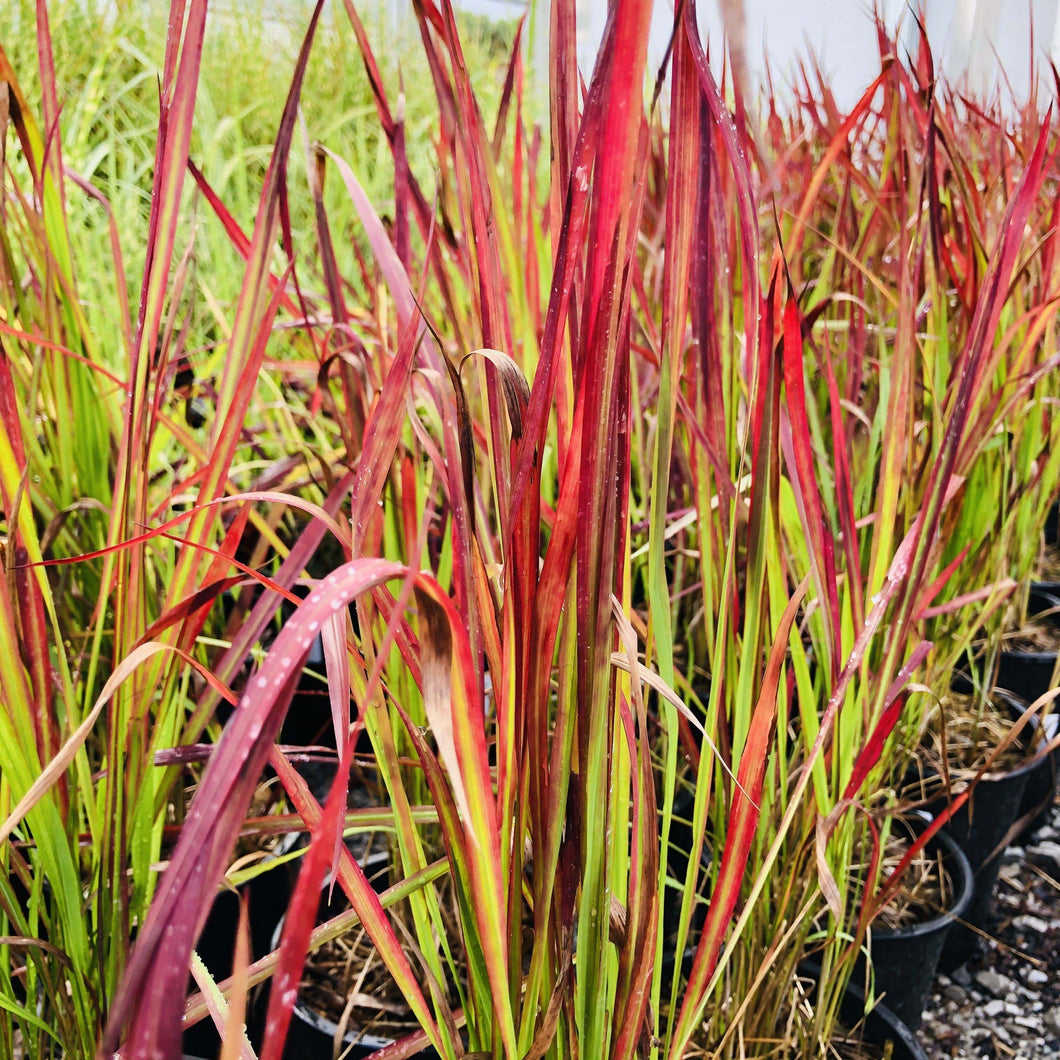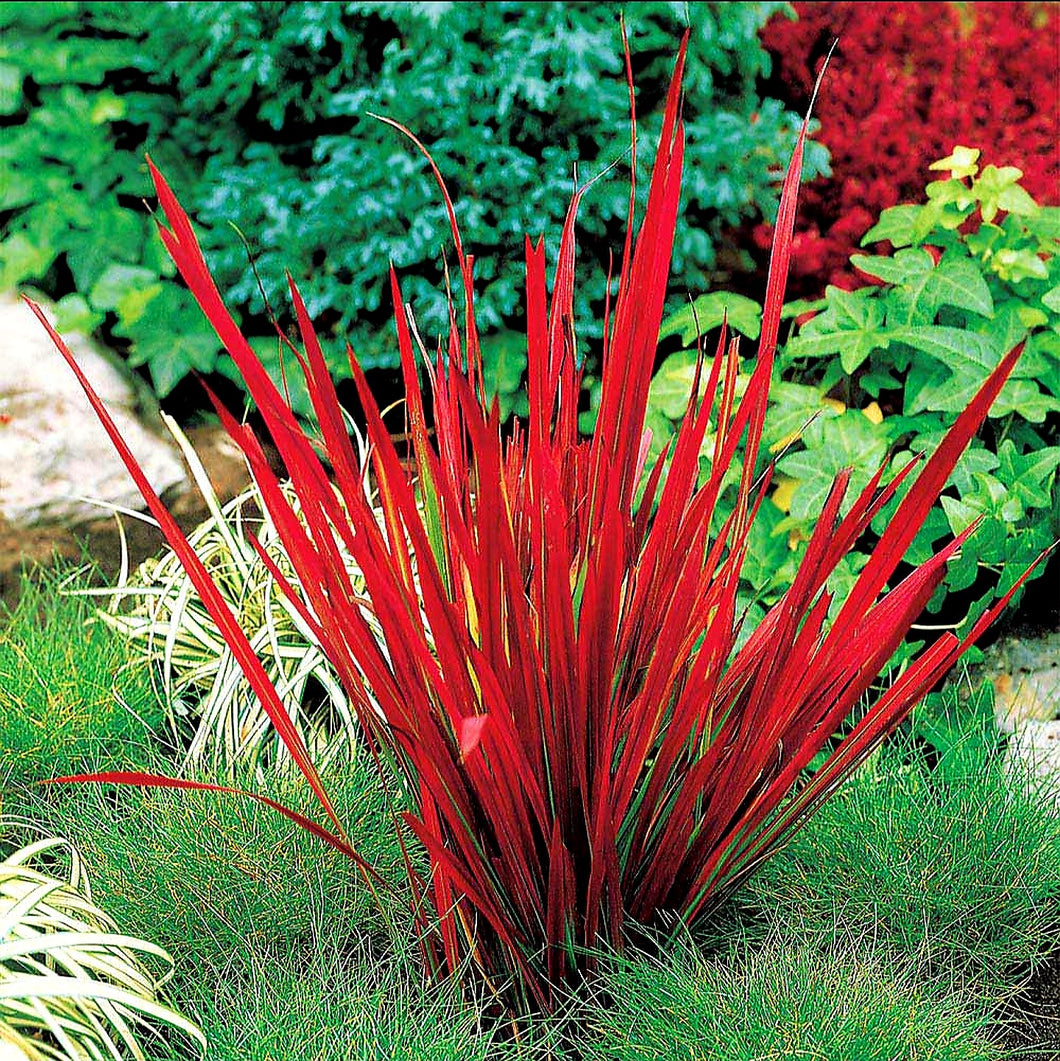Japanese blood grass: A decorative grass plant that gives a layer of vibrant greenery between a walking path, making it ideal for home and business landscaping. The evergreen, long-living plant known as Japanese blood grass (Imperata cylindrica) has spiky leaves. It has stunning leaves that are green at the base and crimson on top, which are visible in the summer and fall.
These distinctive, vibrant grasses enhance the appeal of any scene.
You may add this grass to the border of your garden, which will increase its value and give it a distinctive look with its green-red texture.
The Blossom the plant’s early white blossoms, which are in bloom.
Additionally, make sure that the red variety is what you purchase; stay away from other species because people like and really enjoy the red type because it is distinctive and eye-catching.
Let’s now discuss the origins of this plant and other characteristics of this extraordinary grass species.
Background Details
The two most popular names for these plants (Imperata cylindrica) are kunai grass and cogongrass. These names vary depending on where they were first identified. According to the National Invasive Species Information Center, these grasses were found in subtropical and tropical areas of Southeast Asia (especially Korea, Japan, and China) and East Africa.
Imperata cylindrica is the scientific name for this plant, which belongs to the Poaceae family. Australia, Melanesia, Micronesia, and some regions of Europe were also home to them.
Later, it spread to Latin America, the Caribbean, and the Southeast of the United States.
According to the places it was found in, this grass is also known as sword grass, lalang grass, kura-kura grass, blady grass, and kunai grass, among other names.
This grass spreads approximately 2 cm and can reach heights of 3 to 10 feet (0.7 to 3 meters). Let’s now discuss how to grow this grass in your garden and many factors to consider when planting it.
Invest in Japanese Blood Grass.
PURCHASE CHECK AT AMAZON
ETSY PRICE CHECK
Table of Contents
How to Grow Japanese blood grass (Imperata cylindrica)
For this grass to growBecause these grasses need moist soil and love to thrive in a partially shaded region, prepare well-drained soil and moisten it first. Because of how quickly these plants grow, you should put this grass at least three to forty centimeters away from any walkways or other pedestrian areas.
It also thrives nicely close to ponds since the soil there often receives moisture.
Also, be careful not to overwater; keep the soil moist so that it can develop with little attention. I go into detail about each factor below.
The following points should be kept in mind when growing Japanese blood grass:
Water
Since this grass (Imperata cylindrica) prefers moist soil, water it anytime you need to see fantastic growth. However, keep in mind that they do not do well in dry conditions.
Do not overwater plants, as this may cause their leaves to become brown and eventually fade.
Humidity
This grass can survive in a variety of environments, including low and high humidity levels.
Temperature
It can quickly adapt to a wide range of diverse temperature conditions. It can even grow more on hot days to reach the soil area of your other plants because its rhizomes spread wildly and they grow quickly in warm weather.
Soil
No matter what type of soil you have, these grasses (Imperata cylindrica) can readily tolerate it because they prefer moist soil.
Use nice, healthy soil that drains well if you’d like, and let them become used to the soil.
Light
Give them the recommended 5 to 6 hours of sunlight each day for the light condition; any more won’t help them grow as quickly. They thrive in sunlight and produce vibrant leaves.
Even in the shade, they can survive, but they still need some light to grow.
Fertilizer
When we talk about grass plants, they typically don’t need fertilizer and do well in a variety of soil conditions.
Any type of soil can be used to cultivate Japanese blood grass, and fertilizer can either promote plant development or simply ruin the grass.
Invest in Japanese Blood Grass.
PURCHASE CHECK AT AMAZON
ETSY PRICE CHECK
Potting Repotting
They don’t have a preference for the type of environment in which they are grown; you may grow them in pots, large containers, grounds, and sideways.
When repotting, you must gently grab the root ball and scoop out any additional soil that has accumulated around the roots.
The best time to repot this grass plant is in the spring or in the fall because both of these seasons are fantastic for its growth and rhizomes spread nicely in these seasons.
(Imperata cylindrica) Japanese blood grass Care
The following advice is on how to take care of Japanese blood grass:
It needs sunlight exposure
for at least three to four hours, which will make the red color more vivid.
They look amazing near roadsides and garden corners
But in order for these to look wonderful, they must be moist, so you should feed them water twice a week on hot days or ounces of water.
They retain moisture very well
Therefore, watering is not required, but you can water it if you see that the soil is getting dry.
In Winters these grass requires very less water
Because the moisture content is high in colder settings and can freeze there is no need for additional water; once per week will do.
Some people grow these grasses(Imperata cylindrica) in clay soil
then observe how plants become infected by bacteria or fungus, and frequently their roots start to rot as a result of the moist soil.
Sometimes these grass face problems
Use slug bait to deter them from coming, and avoid overwatering as it may attract neighborhood bugs. When its leaves are eaten by slugs and snails or it becomes infested with rust disease.
(Imperata cylindrica) Japanese blood grass Propagation
Both seeds and dividing the rhizomes of this plant can be used to reproduce it, although for some species, division is the only viable mode of propagation. Since the Red Baron variety is not native to North America, it is either forbidden or subject to restrictions on its proliferation.
How to grow Japanese blood grass is as follows:
1. Its rhizome must be divided together with the leaves themselves.
2. Fall or spring are the optimal seasons for propagation.
3. Don’t worry about separating it; the grass will bounce back quickly and restore its strength.
4. Enjoy.
(Imperata cylindrica) Japanese blood grass Propagation
The best time to prune Japanese blood grass is in the spring because that is when the new leaves will appear. There is no need to prune it in the winter because the leaves displays a lovely mix of half green and half crimson.
Trim the tops or dead leaves to a specific length, and don’t worry—the plant will grow back even more magnificently.
Japanese blood grass for sale
Japanese blood grass is being sold on a number of websites, so i’ve provided links to some of those websites so you may get it there.Here is the Amazon link.
Red baron grass for sale
Red Baron Japanese Blood Grass
PURCHASE CHECK IN AMAZON
Japanese blood grass for sale near me
The only method to find Japanese blood grass for sale nearby is by using an online store or website, as this magnificent grass plant is frequently not offered in local offline markets.
Blood grass seeds
Blood grass seeds are the plant that can be produced using seeds in the simplest way, but you need to ensure that the seeds acquire the right amount of moisture, so watering is required. You need also take careful care of the seeds until they reach a length.
Red baron grass & imperata cylindrica ‘rubra’
The common names for Japanese blood grass are red baron grass and imperata cylindrica “rubra,” as this plant has been cultivated and produced in many different regions of the world, each of which has its own regional name for it.
Can you split Japanese blood grass
Is Japanese blood grass splittable? Yes, you can divide it, and doing so is the most efficient way to propagate this grass species. However, since these are some tough grasses with thick leaves, splitting the leaves by hand may be challenging.
It can spit, however doing so requires both hands, considerable energy, and is tough with one hand.
FAQ’s
Spreads Japanese blood grass? Yes, this Japanese blood grass does spread, but it does so extremely slowly and can survive most types of soil, so if it isn’t pruned, its rhizomes tend to concentrate in particular locations. They have spikey leaves and reach a height of 1.5 to 2 feet.
How is Japanese blood grass cared for? Many items are needed for care. The first thing is healthy soil, and if you accidentally overwater something, stop watering it for a few days until the soil has had a chance to dry up. Its rich colors may appear even more vivid in the full sun. The greatest time to cultivate Japanese blood grass is in the spring, so guard them from snails by using snail bait to stop them from eating the leaves. You should also clip them in the spring before new growth begins.
How is Japanese blood grass propagated? Japanese blood grass can be multiplied easily; just remove the overgrown rhizome and plant it in a new pot; don’t bother about the roots. You can care for your new grass plant while they regenerate. Continue to provide it with water and some sunlight, both of which are crucial during the early stages of growth in moist soil.
Can dogs ingest Japanese blood grass? There are no reports or proof, claims The Animal and Plant Health Inspection Service, that this plant is dangerous or toxic to livestock, including animals like dogs and cats. Therefore, Japanese blood grass is a non-toxic and safe herb.
Conclusion
SEE ALSO:
Full Guide on Growing and Caring for the Jacob’s ladder Plant (Polemonium caeruleum)
Benefits, Propagation, and Care Instructions for Wichita Blue Juniper
How to Grow, Prune, and Take Care of a Gold Mop Cypress [Step By Step]
Care, Pruning, and Propagation of Orange Star Plants [Detailed Guide]



